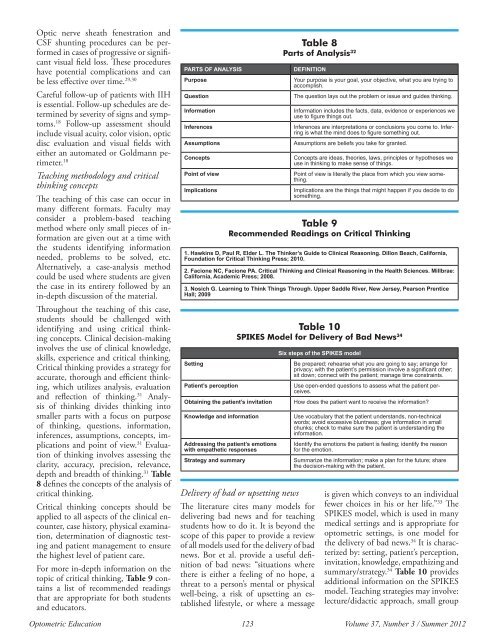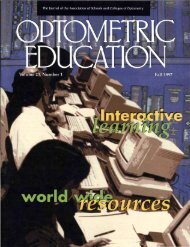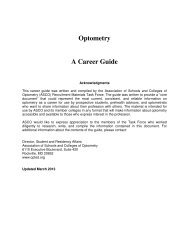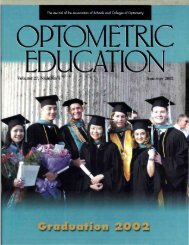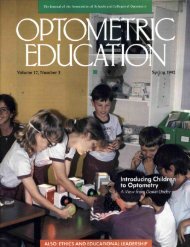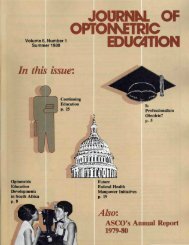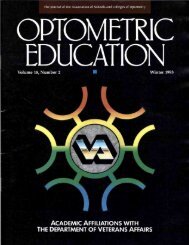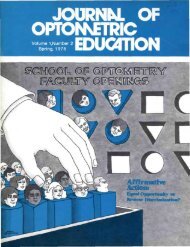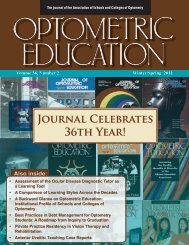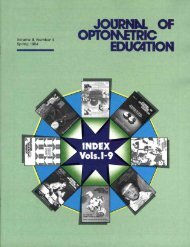Summer 2012, Volume 37, Number 3 - Association of Schools and ...
Summer 2012, Volume 37, Number 3 - Association of Schools and ...
Summer 2012, Volume 37, Number 3 - Association of Schools and ...
You also want an ePaper? Increase the reach of your titles
YUMPU automatically turns print PDFs into web optimized ePapers that Google loves.
Optic nerve sheath fenestration <strong>and</strong><br />
CSF shunting procedures can be performed<br />
in cases <strong>of</strong> progressive or significant<br />
visual field loss. These procedures<br />
have potential complications <strong>and</strong> can<br />
be less effective over time. 29,30<br />
Careful follow-up <strong>of</strong> patients with IIH<br />
is essential. Follow-up schedules are determined<br />
by severity <strong>of</strong> signs <strong>and</strong> symptoms.<br />
18 Follow-up assessment should<br />
include visual acuity, color vision, optic<br />
disc evaluation <strong>and</strong> visual fields with<br />
either an automated or Goldmann perimeter.<br />
18<br />
Teaching methodology <strong>and</strong> critical<br />
thinking concepts<br />
The teaching <strong>of</strong> this case can occur in<br />
many different formats. Faculty may<br />
consider a problem-based teaching<br />
method where only small pieces <strong>of</strong> information<br />
are given out at a time with<br />
the students identifying information<br />
needed, problems to be solved, etc.<br />
Alternatively, a case-analysis method<br />
could be used where students are given<br />
the case in its entirety followed by an<br />
in-depth discussion <strong>of</strong> the material.<br />
Throughout the teaching <strong>of</strong> this case,<br />
students should be challenged with<br />
identifying <strong>and</strong> using critical thinking<br />
concepts. Clinical decision-making<br />
involves the use <strong>of</strong> clinical knowledge,<br />
skills, experience <strong>and</strong> critical thinking.<br />
Critical thinking provides a strategy for<br />
accurate, thorough <strong>and</strong> efficient thinking,<br />
which utilizes analysis, evaluation<br />
<strong>and</strong> reflection <strong>of</strong> thinking. 31 Analysis<br />
<strong>of</strong> thinking divides thinking into<br />
smaller parts with a focus on purpose<br />
<strong>of</strong> thinking, questions, information,<br />
inferences, assumptions, concepts, implications<br />
<strong>and</strong> point <strong>of</strong> view. 31 Evaluation<br />
<strong>of</strong> thinking involves assessing the<br />
clarity, accuracy, precision, relevance,<br />
depth <strong>and</strong> breadth <strong>of</strong> thinking. 31 Table<br />
8 defines the concepts <strong>of</strong> the analysis <strong>of</strong><br />
critical thinking.<br />
Critical thinking concepts should be<br />
applied to all aspects <strong>of</strong> the clinical encounter,<br />
case history, physical examination,<br />
determination <strong>of</strong> diagnostic testing<br />
<strong>and</strong> patient management to ensure<br />
the highest level <strong>of</strong> patient care.<br />
For more in-depth information on the<br />
topic <strong>of</strong> critical thinking, Table 9 contains<br />
a list <strong>of</strong> recommended readings<br />
that are appropriate for both students<br />
<strong>and</strong> educators.<br />
PARTS OF ANALYSIS<br />
Purpose<br />
Question<br />
Information<br />
Inferences<br />
Assumptions<br />
Concepts<br />
Point <strong>of</strong> view<br />
Implications<br />
Setting<br />
Patient’s perception<br />
Obtaining the patient’s invitation<br />
Knowledge <strong>and</strong> information<br />
Addressing the patient’s emotions<br />
with empathetic responses<br />
Strategy <strong>and</strong> summary<br />
Table 8<br />
Parts <strong>of</strong> Analysis 32<br />
DEFINITION<br />
Your purpose is your goal, your objective, what you are trying to<br />
accomplish.<br />
The question lays out the problem or issue <strong>and</strong> guides thinking.<br />
Information includes the facts, data, evidence or experiences we<br />
use to figure things out.<br />
Inferences are interpretations or conclusions you come to. Inferring<br />
is what the mind does to figure something out.<br />
Assumptions are beliefs you take for granted.<br />
Concepts are ideas, theories, laws, principles or hypotheses we<br />
use in thinking to make sense <strong>of</strong> things.<br />
Point <strong>of</strong> view is literally the place from which you view something.<br />
Implications are the things that might happen if you decide to do<br />
something.<br />
Table 9<br />
Recommended Readings on Critical Thinking<br />
1. Hawkins D, Paul R, Elder L. The Thinker’s Guide to Clinical Reasoning. Dillon Beach, California,<br />
Foundation for Critical Thinking Press; 2010.<br />
2. Facione NC, Facione PA. Critical Thinking <strong>and</strong> Clinical Reasoning in the Health Sciences. Millbrae:<br />
California, Academic Press; 2008.<br />
3. Nosich G. Learning to Think Things Through. Upper Saddle River, New Jersey, Pearson Prentice<br />
Hall; 2009<br />
Table 10<br />
SPIKES Model for Delivery <strong>of</strong> Bad News 34<br />
Delivery <strong>of</strong> bad or upsetting news<br />
The literature cites many models for<br />
delivering bad news <strong>and</strong> for teaching<br />
students how to do it. It is beyond the<br />
scope <strong>of</strong> this paper to provide a review<br />
<strong>of</strong> all models used for the delivery <strong>of</strong> bad<br />
news. Bor et al. provide a useful definition<br />
<strong>of</strong> bad news: “situations where<br />
there is either a feeling <strong>of</strong> no hope, a<br />
threat to a person’s mental or physical<br />
well-being, a risk <strong>of</strong> upsetting an established<br />
lifestyle, or where a message<br />
Six steps <strong>of</strong> the SPIKES model<br />
Be prepared; rehearse what you are going to say; arrange for<br />
privacy; with the patient’s permission involve a significant other;<br />
sit down; connect with the patient; manage time constraints.<br />
Use open-ended questions to assess what the patient perceives.<br />
How does the patient want to receive the information?<br />
Use vocabulary that the patient underst<strong>and</strong>s, non-technical<br />
words; avoid excessive bluntness; give information in small<br />
chunks; check to make sure the patient is underst<strong>and</strong>ing the<br />
information.<br />
Identify the emotions the patient is feeling; identify the reason<br />
for the emotion.<br />
Summarize the information; make a plan for the future; share<br />
the decision-making with the patient.<br />
is given which conveys to an individual<br />
fewer choices in his or her life.” 33 The<br />
SPIKES model, which is used in many<br />
medical settings <strong>and</strong> is appropriate for<br />
optometric settings, is one model for<br />
the delivery <strong>of</strong> bad news. 34 It is characterized<br />
by: setting, patient’s perception,<br />
invitation, knowledge, empathizing <strong>and</strong><br />
summary/strategy. 34 Table 10 provides<br />
additional information on the SPIKES<br />
model. Teaching strategies may involve:<br />
lecture/didactic approach, small group<br />
Optometric Education 123 <strong>Volume</strong> <strong>37</strong>, <strong>Number</strong> 3 / <strong>Summer</strong> <strong>2012</strong>


